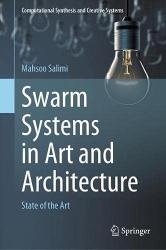Swarm Systems in Art and Architecture: State of the Art
- Добавил: literator
- Дата: 20-10-2021, 04:29
- Комментариев: 0
 Название: Swarm Systems in Art and Architecture: State of the Art
Название: Swarm Systems in Art and Architecture: State of the ArtАвтор: Mahsoo Salimi
Издательство: Springer
Серия: Computational Synthesis and Creative Systems
Год: 2021
Страниц: 138
Язык: английский
Формат: pdf (true), epub
Размер: 36.7 MB
This book presents the recent computational developments inspired by swarms in art known as swarm art and discusses applying swarm intelligence concepts in architecture. Non-human art is a great leap in the evolution of contemporary art, removing the requirement of an artist’s production from the creative process. Furthermore, it is a critical declaration in opposition to the anthropomorphic vision which is so destructive for all other life forms and the planet’s ecology. When accepted and integrated into human culture, non-human art done by artificial systems or machines boosts creativity and stimulates innovative fusions.
We analyze 120 swarm systems with unique and diverse conceptual contexts, agent design, and audience engagement that can be utilized as inspiration for future projects or to design new swarm algorithms by artists, architects, or computer scientists.
Recent advances in Machine Learning have also been used in the context of swarm simulations. Hüttenrauch employed deep reinforcement learning to develop swarm simulations that exhibit more complex collective behaviours than their conventional counterparts. In a similar vein, Machine Learning could also achieve more complex forms of interactions between audiences and swarm artworks.
Most contemporary algorithms are either deterministic or stochastic, and almost all swarm algorithms are stochastic in nature. Swarm algorithms are diverse in terms of their sources of inspiration in nature. There are several different ways of analyzing the essential components of swarm intelligence, such as focusing on the key factors for self-organization. Current research has shown that certain criteria are essential for the success of emergent intelligence through self-organizing behaviours. They include feedbacks, stigmergy, multiple interactions, memory and environmental setting, all of which are very important. All swarm algorithms share similar characteristics including having a population of individual agents capable of moving in a quasi-deterministic manner (algorithmic dynamics). These algorithmic dynamics regulate how the systems evolve, either by a set of predefined procedures (as used in a genetic algorithm) or by a set of equations (as used in PSO).
Swarm algorithms also need a selection mechanism to find the best solution (or best solution to pass on to the next generation). The selection of these states/solutions together with the evolution of the population, allow the system to converge on a set of solutions (often the optimal set). As a consequence, some convergent states or solutions may emerge as iterations.
In this book, I consider the complex landscape of swarm and its applications in art and architecture from different perspectives. First, I explain swarm intelligence and its characteristics, and review some of the basic concepts. In Chap. 2, I examine swarm architecture by exploring agent interaction (internal interaction) and the system dynamic (external interaction). I then review audience interaction and its influence on the overall outcome of the system. In Chap. 3, I explore the underlying concepts, principles, and commonly used algorithms in artistic and architectural practices. I continue the discussion by giving an overview of swarm system outputs in Chap. 4 and their presentation formats in Chap. 5. In Chap. 6, I discuss the challenges and potential of swarm systems and give an overview of future applications. I conclude with a comprehensive taxonomy of the reviewed projects and a detail analysis of their features in the Index Section.
Скачать Swarm Systems in Art and Architecture: State of the Art
Внимание
Уважаемый посетитель, Вы зашли на сайт как незарегистрированный пользователь.
Мы рекомендуем Вам зарегистрироваться либо войти на сайт под своим именем.
Уважаемый посетитель, Вы зашли на сайт как незарегистрированный пользователь.
Мы рекомендуем Вам зарегистрироваться либо войти на сайт под своим именем.
Информация
Посетители, находящиеся в группе Гости, не могут оставлять комментарии к данной публикации.
Посетители, находящиеся в группе Гости, не могут оставлять комментарии к данной публикации.
